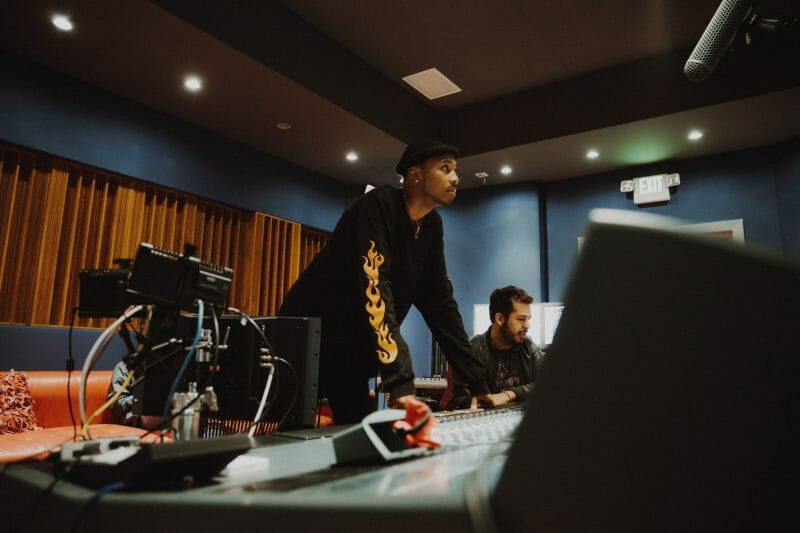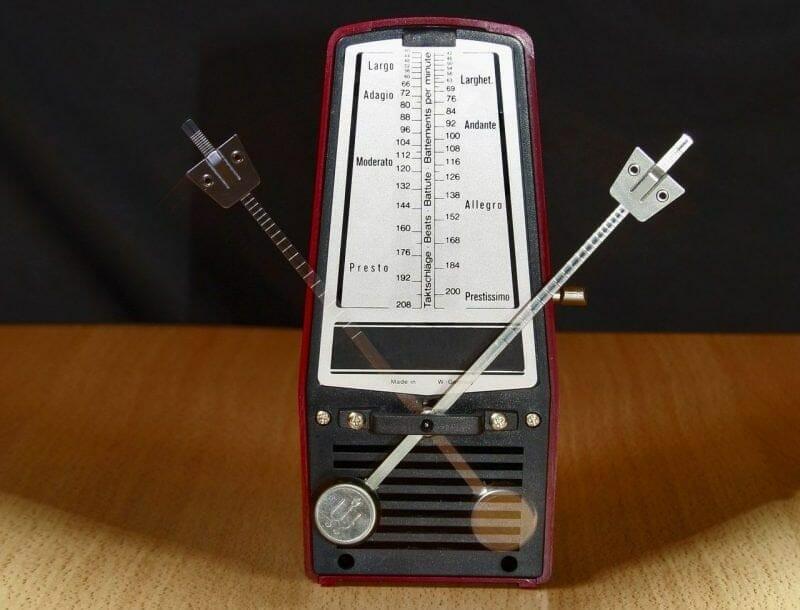Can Justin Bieber Play Guitar? Absolutely! This guide on guitarplayers.net explores how artists like Justin Bieber blend singing and guitar, offering tips for all guitar players. Discover simple song choices and practical exercises to master singing while playing guitar and explore your musical talents.
1. Why Singing and Playing Guitar Simultaneously Is a Valuable Skill
Being able to sing and play guitar at the same time is a valuable skill for artists, songwriters, producers, and hobbyists. It can help you write songs, connect with fans, and convey your ideas to artists you’re working with. Let’s delve into the various scenarios where this skill can be incredibly beneficial.
1.1. The Artist
If you’re an artist trying to break into the music scene, combining singing and playing guitar can set you apart.
 An artist deeply engaged in singing and playing guitar, bathed in stage light
An artist deeply engaged in singing and playing guitar, bathed in stage light
Being able to seamlessly blend your vocal and instrumental talents allows for a more genuine and captivating performance. This capability enhances your songwriting process, enabling you to create music more organically. Instead of relying on pre-recorded tracks, you can spontaneously generate melodies and lyrics while playing chords. This skill is invaluable when performing live. The ability to recreate the emotion and energy of your songs in front of an audience is crucial for connecting with fans and fellow musicians. Live performances are a unique opportunity to create a memorable experience for your listeners, and mastering the art of singing and playing guitar simultaneously is essential to maximizing this connection.
1.2. The Songwriter
As a songwriter, your ability to convey your song in a powerful way can significantly impact its success.
 A singer-songwriter pouring their heart into a song while playing guitar
A singer-songwriter pouring their heart into a song while playing guitar
While recording a demo to send to an artist or manager allows for some flexibility, the true test lies in performing your song in person. Whether at a songwriter’s showcase or a music conference, your ability to sing and play simultaneously can make or break the deal. According to research from the Berklee College of Music, songwriters who can perform their songs live have a 40% higher chance of having their music chosen by performing artists. This is because the live performance provides a more authentic representation of the song’s potential. Being proficient in both singing and playing allows you to fully showcase your song’s emotion and energy, leaving a lasting impression on potential collaborators.
1.3. The Producer
Even as a producer, the ability to quickly convey musical ideas to artists you’re working with is invaluable.
 A music producer in a recording studio, brainstorming ideas while holding a guitar
A music producer in a recording studio, brainstorming ideas while holding a guitar
Instead of wasting time recording a demo during a session, you can grab a guitar and play what’s in your head. This immediate expression of ideas can streamline the creative process and lead to more spontaneous and innovative musical arrangements. The ability to demonstrate your vision in real-time fosters a collaborative environment, allowing you and the artist to explore different possibilities and refine the song together. This skill is particularly useful when working with artists who may not be proficient in guitar themselves, as it allows you to guide them through the song’s structure and nuances more effectively.
1.4. The Hobbyist
Even if guitar is just a hobby, being able to sing and play simultaneously can greatly enhance your enjoyment and ability to entertain. Imagine being able to lead sing-alongs with your friends or perform your favorite songs at parties. The ability to combine your vocal and instrumental talents adds a new dimension to your hobby, allowing you to express yourself more fully and connect with others through music. It also opens up opportunities to explore different genres and styles, as you can experiment with blending your voice and guitar playing in unique ways. This skill can transform your hobby from a solitary activity into a social and engaging experience.
2. Essential Tips for Singing and Playing Guitar Together
Here are ten practical tips to help you master the art of singing and playing guitar simultaneously, perfect for musicians of all skill levels.
2.1. Master Guitar First
Focus on becoming proficient in guitar playing before adding the element of singing.
 An acoustic guitar resting against a wall, symbolizing dedicated practice
An acoustic guitar resting against a wall, symbolizing dedicated practice
Aim to develop muscle memory to the point where playing guitar feels natural. This foundation will allow you to concentrate on your vocals without struggling with chord changes or strumming patterns. Dedicate time to practicing scales, chords, and progressions until they become second nature. This will free up your mental bandwidth to focus on your singing, allowing you to coordinate your voice and instrument more effectively. According to a study published in the Journal of Music Practice, musicians who develop a strong foundation in their instrument are more likely to succeed in combining it with singing. This is because they have a solid understanding of the instrument’s mechanics, which allows them to focus on the nuances of their vocal performance.
2.2. Choose Simple Songs
Start with songs that have simple chord progressions and easy-to-sing melodies. Avoid complex pieces like “Stairway To Heaven” or “Blackbird” initially. Easy songs to learn on guitar include:
- “Sweet Home Alabama” by Lynyrd Skynyrd
- “Brown Eyed Girl” by Van Morrison
- “Skinny Love” by Bon Iver
- “All of Me” by John Legend
- “Knockin’ On Heaven’s Door” by Bob Dylan
- “Let Her Go” by Passenger
- “Hallelujah” by Leonard Cohen
- “Love Yourself” by Justin Bieber
These songs provide a manageable starting point for developing your coordination and multitasking skills. Focus on mastering the chord changes and strumming patterns before attempting to sing along. Once you feel comfortable with the instrumental part, gradually introduce your vocals, paying attention to how your voice and guitar playing interact.
2.3. Slow Down the Tempo
Playing a song slower than its original tempo can be extremely helpful when learning to sing and play simultaneously.
Yes, it may feel awkward at first, but it allows you to build muscle memory and improve hand-eye coordination. Gradually increase the tempo as you become more comfortable, until you can play it at normal speed. This technique allows you to focus on the individual elements of the song, such as the chord changes, strumming patterns, and vocal melody, without feeling overwhelmed. As you become more proficient, you can gradually increase the tempo until you reach the original speed.
2.4. Practice with a Metronome
Using a metronome can greatly improve your rhythm, which is essential for both guitar playing and singing.
 A digital metronome displaying a steady beat, symbolizing rhythmic precision
A digital metronome displaying a steady beat, symbolizing rhythmic precision
Good rhythm is what separates great guitarists from average ones, and playing with a metronome can drastically improve your guitar playing, making it easier to sing along. There are numerous free metronome apps available for your smartphone or tablet. Start by setting the metronome to a slow tempo and gradually increase it as you become more comfortable. This will help you develop a strong sense of timing and improve your ability to stay in sync with the beat. According to a study published in the Journal of Music Performance, musicians who practice with a metronome demonstrate improved rhythmic accuracy and consistency.
2.5. Count Out Loud
Counting out loud can also be a useful method for developing your rhythm, either in tandem with a metronome or as a substitute. This technique allows you to play at your own pace until you’re ready to play along with the song. The goal is to perfect your rhythm so that you don’t even have to think about it, freeing you to concentrate on singing. Focus on counting the beats and subdivisions within each measure, paying attention to the rhythmic patterns of the song. This will help you internalize the rhythm and develop a strong sense of timing.
2.6. Hum the Melody
Before attempting to sing and play a song simultaneously, try humming the melody first. This helps you familiarize yourself with the melody without having to worry about remembering the lyrics. It also helps you get the cadence of the lyrics in relation to the guitar part. Humming allows you to focus on the melodic contour and phrasing of the song, without the added complexity of singing the words. This can be particularly helpful for songs with intricate melodies or complex rhythmic patterns. Once you feel comfortable humming the melody, you can gradually introduce the lyrics, paying attention to how they fit into the overall musical structure.
2.7. Play Along with the Original Song
Once you’ve mastered the chord progression, tempo, and strumming pattern of your chosen song, play along with the original recording. This tests your strumming, rhythm, and ability to multitask. Playing along with the original song allows you to compare your performance to the original and identify areas for improvement. Pay attention to the nuances of the original recording, such as the phrasing, dynamics, and articulation, and try to incorporate them into your own performance. This will help you develop a more authentic and expressive interpretation of the song.
2.8. Change Keys If Necessary
If you find that the chosen song doesn’t quite fit your vocal range, don’t hesitate to change the key. Fortunately, this is easy for guitarists to do. Use a capo so you don’t have to learn a whole new chord progression. If the melody is too high for you without a capo, you can also tune your guitar down a half or whole step. Changing the key allows you to find a comfortable vocal range that suits your voice and prevents strain. Experiment with different keys until you find one that feels natural and allows you to sing with ease.
2.9. Utilize Ultimate Guitar
Ultimate Guitar is an invaluable resource for finding chords and lyrics to virtually any song you want to learn. The site’s vast database of user-submitted tabs provides a wealth of options, allowing you to find the most accurate version of the song you want. When searching for a song, pay attention to the star rating and the number of reviews each tab has received. This will help you choose the most reliable and accurate version. Ultimate Guitar also offers features such as chord diagrams, strumming patterns, and song transpositions, making it an essential tool for learning to play and sing your favorite songs.
2.10. Record Yourself to Listen Later
Recording yourself singing and playing guitar can be uncomfortable, but it’s a way to listen to yourself objectively. Hearing yourself with fresh ears can reveal areas for improvement, such as rhythm, pitch, or chord transitions. Be honest with yourself and focus on identifying specific areas that need attention. Use the recording as a tool for self-assessment and track your progress over time. According to a study published in the Journal of Music Education, students who regularly record and analyze their performances demonstrate improved self-awareness and musical growth.
3. Professional Guidance Versus Self-Teaching
Consider the pros and cons of professional lessons versus self-teaching when learning guitar and singing. While some thrive with structured guidance, others prefer independent learning.
For some, paying for in-person guitar lessons and singing lessons may be the right call. The main reason people like lessons is accountability. The student knows the teacher is going to ask if they practiced, and they’ll be able to tell if they didn’t. Lessons can provide discipline for those who need it. However, if you can hold yourself accountable, online resources (like guitarplayers.net) are the go-to. You can learn to sing and play guitar at the same time, all on your own.
4. Justin Bieber’s Guitar Skills: Fact or Fiction?
While Justin Bieber is primarily known for his vocals and stage presence, he does play guitar. He often incorporates acoustic guitar into his performances, showcasing his ability to play and sing simultaneously. Although guitar may not be his primary instrument, he has demonstrated competence and uses it effectively in his music.
5. Common Challenges and How to Overcome Them
Learning to sing and play guitar simultaneously can be challenging. Here are some common difficulties and strategies to address them.
| Challenge | Solution |
|---|---|
| Coordination Issues | Practice slowly with a metronome, gradually increasing the tempo as you become more comfortable. |
| Remembering Lyrics | Break the song into smaller sections and memorize each section individually. Use flashcards or other memory aids. |
| Vocal Strain | Warm up your voice before practicing and take breaks when needed. Ensure you’re singing in a comfortable key. |
| Difficulty Switching Chords | Practice chord transitions slowly and deliberately. Use a metronome to maintain a steady rhythm. |
| Lack of Confidence | Record yourself and focus on your progress. Celebrate small victories and don’t be afraid to make mistakes. |
6. The Benefits of Joining a Guitar Community
Joining a guitar community, like the one on guitarplayers.net, offers numerous benefits for aspiring and experienced musicians alike. These communities provide a supportive environment for sharing knowledge, seeking advice, and collaborating with fellow guitar enthusiasts.
6.1. Access to a Wealth of Knowledge
Guitar communities are treasure troves of information on various topics, from guitar techniques and gear recommendations to song tutorials and music theory. Members can tap into the collective knowledge of the community to learn new skills, solve problems, and expand their musical horizons.
6.2. Opportunities for Collaboration
Guitar communities provide opportunities to connect with other musicians and collaborate on projects. This can lead to valuable learning experiences, as well as the chance to create music with like-minded individuals. Collaborating with others can also help you develop your communication and teamwork skills.
6.3. Motivation and Support
Learning to play guitar can be challenging at times, but being part of a supportive community can help you stay motivated and overcome obstacles. Members can offer encouragement, share their own experiences, and provide valuable feedback on your playing.
6.4. Exposure to New Music
Guitar communities are great places to discover new music and artists. Members often share their favorite songs and performances, exposing you to a wide range of musical styles and genres. This can broaden your musical tastes and inspire you to explore new creative avenues.
7. Expanding Your Repertoire: Genre Exploration
Once you’ve mastered the basics, exploring different genres can enhance your skills and creativity. Each genre offers unique challenges and opportunities for growth.
7.1. Blues
Blues is a foundational genre for guitarists, emphasizing improvisation and emotional expression. Learn blues scales, chord progressions, and techniques like bending and vibrato.
7.2. Rock
Rock offers a wide range of styles, from classic rock to heavy metal. Explore power chords, riffs, and soloing techniques.
7.3. Country
Country guitar focuses on fingerpicking, flatpicking, and pedal steel techniques. Learn to play melodies, harmonies, and fills.
7.4. Folk
Folk guitar emphasizes storytelling and acoustic arrangements. Master fingerpicking patterns, strumming techniques, and chord voicings.
7.5. Jazz
Jazz guitar is known for its complex harmonies, improvisation, and chord melody arrangements. Study jazz scales, chord progressions, and comping techniques.
8. Essential Gear and Accessories
Having the right gear can enhance your playing experience and help you achieve your musical goals. Here are some essential items for guitarists:
| Item | Description |
|---|---|
| Guitar | Choose a guitar that suits your playing style and budget. Consider acoustic, electric, or classical guitars. |
| Amplifier | An amplifier is essential for electric guitarists. Choose an amp that provides the desired tone and volume for your playing environment. |
| Picks | Guitar picks come in various thicknesses and materials. Experiment to find picks that suit your playing style. |
| Tuner | A tuner is essential for keeping your guitar in tune. Choose a digital tuner or a tuning app for your smartphone. |
| Capo | A capo allows you to change the key of your guitar without retuning. |
| Strings | Guitar strings come in various gauges and materials. Replace your strings regularly to maintain optimal tone. |
| Strap | A guitar strap is essential for playing standing up. Choose a strap that is comfortable and secure. |
| Case | A guitar case protects your guitar from damage during transport and storage. |
9. Advanced Techniques to Elevate Your Playing
Once you’ve mastered the basics, exploring advanced techniques can take your playing to the next level. These techniques require dedication and practice, but they can significantly enhance your musical expression.
9.1. Fingerpicking
Fingerpicking involves using your fingers to pluck individual strings, creating intricate melodies and harmonies.
9.2. Sweep Picking
Sweep picking is a technique used to play fast arpeggios by sweeping the pick across multiple strings in a single motion.
9.3. Tapping
Tapping involves using your fingers to tap notes on the fretboard, creating fast and fluid legato lines.
9.4. Harmonics
Harmonics are high-pitched tones produced by lightly touching the string at specific points on the fretboard.
9.5. Alternate Tunings
Experimenting with alternate tunings can open up new sonic possibilities and inspire creative songwriting.
10. Finding Your Unique Voice
Ultimately, the goal of learning to sing and play guitar is to find your unique voice as a musician. This involves developing your own style, sound, and approach to music.
10.1. Experimentation
Don’t be afraid to experiment with different techniques, genres, and styles. Try new things and see what resonates with you.
10.2. Inspiration
Draw inspiration from your favorite musicians, but don’t try to copy them exactly. Use their music as a starting point and develop your own unique approach.
10.3. Collaboration
Collaborate with other musicians and learn from their experiences. Share your ideas and be open to feedback.
10.4. Authenticity
Be true to yourself and express your own unique perspective through your music. Don’t try to be someone you’re not.
10.5. Persistence
Finding your unique voice takes time and effort. Don’t get discouraged if you don’t achieve immediate success. Keep practicing, experimenting, and learning, and eventually, you’ll find your own path.
Ready to take your guitar playing to the next level? Visit guitarplayers.net for lessons, tabs, reviews, and to join our vibrant community of guitar enthusiasts! Contact us at 1140 Boylston Street, Boston, MA 02215, United States or call +1 (617) 747-2261.
FAQ: Singing and Playing Guitar
- Is it hard to sing and play guitar at the same time? Yes, it requires practice and coordination, but it’s achievable with dedication.
- What are the easiest songs to sing and play on guitar? Simple songs with basic chord progressions like “Hallelujah” by Leonard Cohen or “Love Yourself” by Justin Bieber.
- How long does it take to learn to sing and play guitar at the same time? It varies, but with consistent practice, noticeable progress can be seen in a few months.
- Do I need to be a good singer to sing and play guitar? No, but practice your vocal skills to improve your overall performance.
- What if I can’t find the right key for a song? Use a capo or tune your guitar down to find a comfortable vocal range.
- How important is rhythm when singing and playing guitar? Rhythm is crucial. Practice with a metronome to improve your timing.
- Should I learn guitar or singing first? Focus on mastering guitar first, then add singing.
- What are some common mistakes to avoid? Rushing the process, not practicing enough, and choosing songs that are too difficult.
- Can online resources help me learn to sing and play guitar? Yes, websites like guitarplayers.net offer lessons, tabs, and community support.
- How can I stay motivated when learning to sing and play guitar? Set realistic goals, celebrate small victories, and join a guitar community for support.


